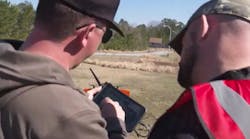By Jason Tyre, Business Development Manager, Cities, Milestone Systems
Police departments nationwide are increasingly adopting unmanned aerial vehicles (UAVs), commonly known as drones, to enhance their operational and response capabilities. Providing enhanced situational awareness and increasing officer safety, drones are becoming a vital force multiplier and cost-effective tool, helping law enforcement extend their reach and do more with limited human resources.
However, to fully capitalize on the potential of UAVs, departments need intelligent solutions for managing video data. Integrating UAVs with data-driven, open platform, video management software (VMS) enables the seamless capture, distribution, analysis, and storage of video data for optimum efficiency and security.
Expanding Police Capabilities
As law enforcement departments race to modernize while doing more with less resources, the use of UAVs is becoming increasingly critical. Small units provide real-time aerial views of unfolding situations, while larger uncrewed aircraft can provide two-way audio communications or deliver supplies during complex emergencies. According to industry estimates, nearly 1,000 state and local police, sheriff, fire, and emergency agencies in the U.S. are now using UAVs.
In the early years of use, many agencies relied on drones for static, tactical surveillance of hostage situations and missing person cases. But today, drones are being deployed proactively as "first responders" to priority 911 calls ahead of patrol units, providing critical situational awareness for arriving officers.
For example, a police department in San Diego County, California, has pioneered launching drones from strategic locations around the city. The UAV provides initial aerial imagery and live video feeds to give responding personnel greater situational awareness and operational intelligence to respond to critical incidents and events safely, effectively, and efficiently as they unfold in real time. This innovative approach has enabled faster response times, enhanced decision making, effective resource management, and increased safety for the citizens and communities they serve.
Other forward-looking departments are also testing and deploying drones for vehicle pursuits, crowd monitoring, tactical operations, crime scene reconstruction, missing persons, and potential replacement of expensive helicopters. Camera-equipped quadcopters have tracked suspects fleeing crimes on foot after jumping from getaway vehicles. Small units can be used to shadow demonstration march routes to estimate crowd sizes and alert ground forces about developing incidents. As unit costs fall and capabilities and usability increase, the agile drone is securing a role alongside traditional air support assets.
Streaming and Capturing UAV Video
As drone use continues to grow, departments often struggle with integrating the video data into existing systems and workflow practices. Most UAV video systems operate as separate silos, requiring police personnel to monitor and control multiple applications simultaneously across different devices. To add to the complexity, streaming any data from drones to ground systems usually requires converting the native UAV controller video output into an IP video format compatible with the desired solution. This is commonly achieved using an HDMI video encoder to transform the feed for networking applications.
A popular shortcut relies instead on a UAV manufacturer’s cloud platform to convert and host the video streams online. However, cloud solutions often lack sophisticated graphics, analysis tools, and access control standards found in enterprise VMS platforms. The video management limitations of standalone UAV operations are motivating agencies to invest in tighter video data integration.
Networking Drones and VMS
Departments are achieving productivity gains by routing UAV video feeds directly into their centralized video management systems. VMS solutions offer exceptional interoperability, integrating disparate video hardware and data sources into unified system dashboards and interfaces. When networked into a VMS, real-time drone video can be wirelessly and simultaneously distributed to laptops, tablets, mobile phones, command vehicles, and operation centers.
An open platform VMS offers incredible versatility thanks to its available application programming interfaces (APIs). These interfaces allow the VMS to ingest and associate data from virtually any sensor or data source. Developers can build custom integrations between new and legacy systems, including acoustic detection, air quality monitors, license plate readers, and more.
The open APIs also ensure that users aren't locked into proprietary technology vendors or ecosystems. Departments can seamlessly deploy innovative new hardware and software solutions as technologies develop without needing to prematurely rip and replace their existing systems, saving critical public funds.
Today’s open platform VMS also archives the UAV data alongside bodycam and other video systems for simplified evidence management. Streamlined case video review with different viewing angles allows more accurate incident reconstruction — especially with the help of today’s AI-powered video analytic solutions.
Implementing Best Practices
As drone adoption accelerates, departments must balance the enormous potential benefits with privacy concerns. This requires investing in qualified and trained staff while establishing clear policies and procedures to manage when and how these assets are deployed and managed.
Equally important are the implementation of standard operating procedures governing when drones can deploy, what recording occurs, and strict data access rules. An enterprise-level, open platform VMS delivers the necessary tools, system hardening, and cybersecurity controls to enable compliance with the following privacy best practices.
Operators should adopt the following UAV operation guidelines:
- Follow FAA regulations: Always stay updated on and comply with FAA regulations for UAV operations, including flight path restrictions, altitude limitations, and registration requirements.
- Develop clear policies and procedures: Establish specific policies governing pilot training, certification, mission planning, data privacy, and use-of-force scenarios involving UAVs.
- Prioritize safety and privacy: Conduct flights only in authorized areas, minimizing risks to individuals and property. Respect reasonable expectations of privacy and avoid capturing unnecessary personal data.
- Invest in pilot training: Ensure pilots receive thorough training on safe and responsible UAV operation, including emergency procedures, weather awareness, and de-escalation techniques.
Operators should comply with the following video data handling, storage, and sharing guidelines:
- Clearly define data retention policies: Establish clear guidelines for how long data is stored based on its sensitivity and evidentiary value. Regularly review and delete data according to established protocols.
- Implement robust security measures: Securely store collected data using encryption and access control mechanisms to prevent unauthorized access, manipulation, or loss.
- Limit data sharing: Share data only on a need-to-know basis with authorized personnel. Develop clear protocols for sharing with other law enforcement agencies or third parties, complying with relevant data privacy laws.
- Maintain chain of custody: Establish a chain of custody protocol to document the handling of data from collection to final disposition, ensuring its integrity as evidence.
UAV Innovations on the Horizon
Video security and law enforcement professionals are already envisioning the next generation of public safety drones enhanced by open, data-driven, VMS-enabled capabilities. UAVs equipped with gunshot sensors could instantly self-deploy toward firearm discharges to track suspects. Environmental sensors could map spill sites or fire hotspots to safeguard responding units. Advanced analytics may even forecast crowd behavior and traffic incidents by analyzing aerial movement patterns.
An open platform VMS provides the ideal foundation for departments seeking to maximize emerging technologies. With their inherent flexibility, integrations, and scalable architecture, open VMS solutions readily support both current and future drone innovations as they become available.
By selecting solutions designed specifically for continuous interoperability advancement, police departments enable their officers to capitalize on new technologies over time, keeping communities safer while equipping personnel with vital information. With rapid progress on the horizon, flexible, scalable, data-driven platforms will prove indispensable to law enforcement for future adaptability.




